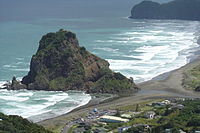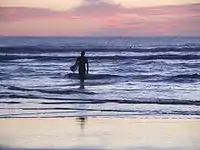Piha
Piha is a coastal settlement on the western coast of the Auckland Region in New Zealand. It is one of the most popular beaches in the area and a major day-trip destination for Aucklanders throughout the year, and especially in summer.


Piha is 39 kilometres west of Auckland city centre, on the Tasman Sea coast to the north of the Manukau Harbour, on the western edge of the Waitākere Ranges. Immediately to the north of Piha is Whites Beach, and immediately to the south is Mercer Bay; land access to both is only by foot. The nearest beaches accessible by road are Karekare to the south, and Anawhata to the north.
Demographics
| Year | Pop. | ±% p.a. |
|---|---|---|
| 2006 | 822 | — |
| 2013 | 858 | +0.61% |
| 2018 | 984 | +2.78% |
| Source: [1] | ||
Piha had a population of 984 at the 2018 New Zealand census, an increase of 126 people (14.7%) since the 2013 census, and an increase of 162 people (19.7%) since the 2006 census. There were 396 households. There were 498 males and 486 females, giving a sex ratio of 1.02 males per female. The median age was 43.4 years, with 189 people (19.2%) aged under 15 years, 108 (11.0%) aged 15 to 29, 561 (57.0%) aged 30 to 64, and 129 (13.1%) aged 65 or older.
Ethnicities were 94.8% European/Pākehā, 13.4% Māori, 3.4% Pacific peoples, 3.0% Asian, and 2.1% other ethnicities (totals add to more than 100% since people could identify with multiple ethnicities).
The proportion of people born overseas was 19.2%, compared with 27.1% nationally.
Although some people objected to giving their religion, 66.8% had no religion, 18.9% were Christian, and 5.8% had other religions.
Of those at least 15 years old, 279 (35.1%) people had a bachelor or higher degree, and 48 (6.0%) people had no formal qualifications. The median income was $42,700. The employment status of those at least 15 was that 429 (54.0%) people were employed full-time, 129 (16.2%) were part-time, and 21 (2.6%) were unemployed.[1]
Features and geology

As well as two surf beaches there are also a sheltered lagoon and several streams in the area. The coastline and forested Waitākere Ranges offer a number of walks, or tramps, ranging from easy to very difficult. Due to the spread of the incurable kauri dieback disease large parts of the Waitākere Ranges were closed from 2018 until further notice.[2]
Piha is a well known black sand beach, due to the high iron content, which is of volcanic origin.
Lion Rock is a natural formation dividing North and South Piha beaches. It is an eroded 16-million-year-old [3] volcanic neck,[4] named for its similarity to a lying male lion when viewed from the rear (shore side), Lion Rock is immediately visible to visitors as they descend along the only access road. Lion Rock has become iconic not only of Piha, but of Auckland's West Coast in general. The rock was settled in Pre-European times by Māori, and was the location of the Whakaari Pā. Archaeological surveys have shown the remains of platforms, midden and terraces on Lion Rock, as well as fragments of traditional textiles, dating back to a time before European contact.[5] Lion Rock was featured on stamps as well as an Auckland phone book, and in December 1919 a memorial to local sawmillers who served in World War One was unveiled on Lion Rock.[6]
About 2 km inland, on the Glen Esk stream, are the Kitekite Falls which while not very large are picturesque. Swimming is possible all seasons (though only for the cold hardened outside of summer) in a pool just above the falls. At the bottom of the falls is a sheltered picnic area popular with families in the summer time.
About 2 km inland, on the Piha stream, is a small canyon..[7]
About 1 km south of the South Beach is 'The Gap', which at low tide provides another lagoon and a blowhole.
Surfing

Piha was the birthplace of New Zealand board riding in 1958, and has been the scene of both New Zealand national and international surfing championship competitions.
Surf lifesaving
Two surf lifesaving clubs provide surf patrols in summer. Piha Surf Life Saving Club, the home of the TV series Piha Rescue, patrols the section of the beach to the south of Lion Rock. United North Piha Lifeguard Service is responsible for the section of the beach north of Lion Rock. Both clubs provide patrolled areas designated by red and yellow flags as is the custom with Surf Lifesaving in New Zealand and many other countries.
Safety information
The rip currents along this section of coast are very unpredictable and can shift with little warning. They claim many lives despite the efforts of surf life-savers. Most of these drownings, however, occur after lifeguards are off duty or after rock fisherman wearing heavy clothing are washed off rocks, out of sight of the lifeguards. Lifeguards advise swimming between the red and yellow flags, during patrol hours.
After the death of two men at Piha in February 2013, lifeguards say the water fools swimmers by appearing deceptively calm, obscuring strong rips, and people should stay out of the water if they aren't confident swimmers.[8]
Piha Rescue
Piha Beach was the setting for a popular New Zealand reality television show. Aptly named Piha Rescue, it ran for 12 series over 14 years on TV1 and it featured the lives of the surf life savers at Piha Beach and educated the public on the beach safety, rip currents and swimming between the flags.[9]
Photo gallery

 Breaking wave, North Piha
Breaking wave, North Piha Piha and Lion Rock from the access road above
Piha and Lion Rock from the access road above Piha after Sunset
Piha after Sunset North to Lion rock and Te Waha Point
North to Lion rock and Te Waha Point 'The Last Ride'
'The Last Ride' 'Ridges of Intrigue'
'Ridges of Intrigue' Toetoe plumes and Lion Rock
Toetoe plumes and Lion Rock
References
- "Statistical area 1 dataset for 2018 Census". Statistics New Zealand. March 2020. Piha (124100). 2018 Census place summary: Piha
- Council, Auckland. "Protect our kauri trees". Auckland Council. Retrieved 2018-09-04.
- "Geology of Waitākere Ranges".
- Ewen Cameron; Bruce Hayward; and Graeme Murdoch (1997). A Field Guide to Auckland: Exploring the Region's Natural and Historic Heritage, p. 168. Godwit Publishing Ltd, Auckland. ISBN 1-86962-014-3.
- McKendry, Lisa (2017). "Māori Kākahu (Cloak) Fragments from Piha: Whakaari Pā". Records of the Auckland Museum. 52: 59–70.
- 'Roll of Honour Unveiled', New Zealand Herald, 8 December 1919, Page 10.
- "www.newzealand.com". Archived from the original on 2010-05-22. Retrieved 2011-05-13.
- "Be careful in the water, urges lifeguard". 3 News NZ. February 25, 2013.
- Rescue, Piha. "Piha Rescue Cancelled".
External links
| Wikivoyage has a travel guide for Piha. |
| Wikimedia Commons has media related to Piha. |
- Piha.co.nz - News, History, Environment and Information
- About Piha. A History of Surfing in Piha.
- Photographs of Piha held in Auckland Libraries' heritage collections.
- Photographs of buses to Piha - 1940s , .
